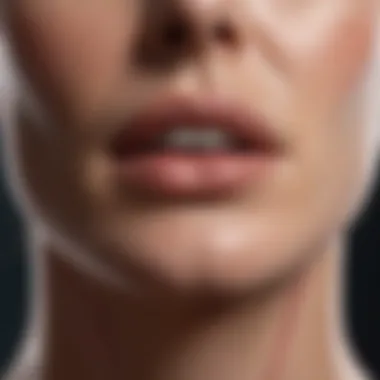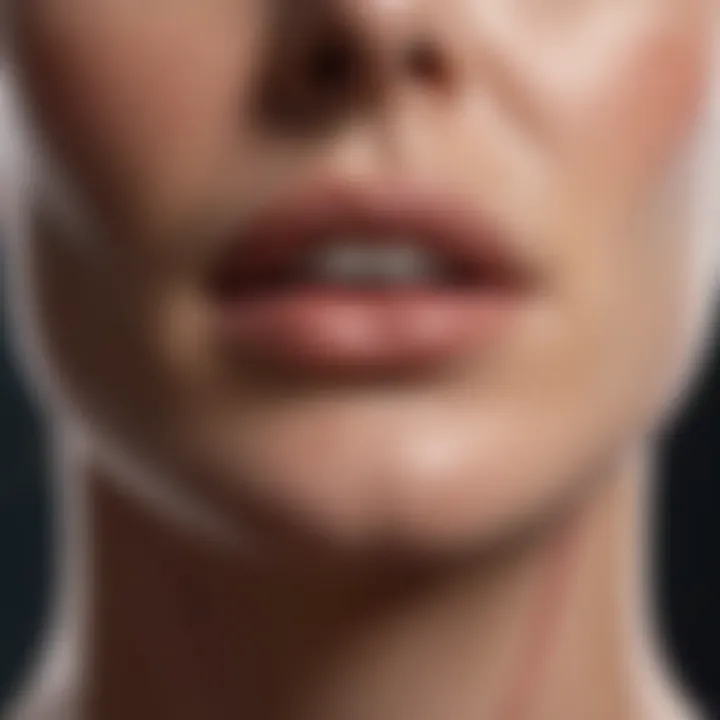Breakouts Under the Chin: Causes and Remedies


Intro
Breakouts under the chin are a skin concern that can feel quite frustrating. Despite being a prevalent issue, many people don’t often give them the attention they deserve. These blemishes can stem from a variety of causes, ranging from hormonal changes to dietary habits, and understanding them can significantly enhance one’s skincare routine. This section will provide insight into why these breakouts occur, how to prevent them, and what remedies are most effective.
Fashion Trends
While skincare may seem unrelated to fashion, trends in both areas often intersect. Maintaining clear skin can be a platform for confidence, which is essential when showcasing seasonal styles.
Seasonal Styles
Regardless of the season, styles change and so do fabric choices. Some materials, such as wool or synthetic blends, may cause irritation for those sensitive to them. Choosing breathable fabrics less likely to trap sweat and oil can reduce acne potential.
- Spring: Light cottons and linens are great, allowing skin to breathe.
- Summer: Opt for moisture-wicking fabrics to keep sweat at bay.
- Autumn/Winter: Consider layering with soft, gentler materials to avoid friction on the chin area.
Influencer Inspirations
Today, influencers play a significant role in shaping fashion choices. Many beauty and style influencers highlight their skincare routines alongside fashion advice. They often share how they combat breakouts under the chin through both their skin regimen and clothing choices. Following their tips can give unique ideas on blending skincare with personal style.
"Taking care of your skin is like choosing a foundational color for your wardrobe; it sets the stage for everything else."
Beauty Tips
Beauty is not all about products; it’s about the whole routine. This section will discuss practical steps for effective skincare and makeup techniques.
Skincare Routines
A consistent skincare routine can work wonders in preventing breakouts. Below are some essential steps:
- Cleansing: Use a gentle cleanser twice daily to remove dirt and excess oil.
- Exfoliating: Incorporate a mild exfoliant weekly to get rid of dead skin cells that can clog pores.
- Moisturizing: Hydrate the skin to keep it balanced; look for non-comedogenic products that won’t block pores.
Makeup Techniques
Makeup can enhance beauty but also contribute to skin issues if applied improperly. Here are a few things to consider:
- Choose Non-Comedogenic Products: Always look for labels that specify non-comedogenic, as these are less likely to clog pores.
- Clean Brushes Regularly: Brushes and sponges can harbor bacteria, so keep them clean to prevent breakouts.
- Remove Makeup Before Bed: Never skip removing makeup at night; it allows skin to breathe and heal.
Remedies
Addressing existing breakouts under the chin calls for informed remedies that go beyond topical treatments.
- Tea Tree Oil: This natural remedy has anti-inflammatory properties that can calm irritated skin.
- Salicylic Acid: A common ingredient in anti-acne products, it penetrates pores to keep them clear.
- Zinc Supplements: Some people find that taking zinc can help reduce breakouts due to its anti-inflammatory nature.
These suggestions can serve as a foundation for tackling breakouts effectively. Alongside these remedies, staying informed about triggers and proper skincare customization contributes to long-term results.
Epilogue
Understanding breakouts under the chin calls for an interplay between knowledge of skin health and lifestyle. It requires a tailored approach that considers fashion choices, skincare, and makeup application. With the proper understanding and measures, one can reduce the interesting complications of these pesky blemishes, paving the way for clearer skin and enhanced confidence.
Preface to Chin Breakouts
Chin breakouts can feel like an unwelcome surprise, often popping up at the most inconvenient times. Understanding why these blemishes occur is essential, especially for women across all age groups who want to maintain a clear complexion. By delving into the reasons behind these skin issues, one can better tackle the problem and develop effective prevention and treatment strategies.
The skin under the chin is unique, often experiencing factors that can contribute to breakouts. For instance, hormonal fluctuations, which many women face throughout their lives, play a significant role. These fluctuations can trigger excess oil production, leading to clogged pores and, ultimately, zits. Not only that, but lifestyle choices—ranging from diet to stress levels—can also exacerbate the situation.
In many cases, chin breakouts are often mistakenly attributed solely to external factors like the products one uses or even touching the face. However, it is essential to recognize the holistic interplay between body and skin. This wider lens helps in understanding one’s own skin health, making it possible to take informed actions.
As we explore the various aspects of chin breakouts, including their causes, methods of prevention, and remedies, it becomes clear that knowledge is power. By identifying the underlying reasons for these stubborn spots, individuals can cultivate a robust skincare routine tailored to their unique needs.
"Skin is often a reflection of inner health; what happens beneath the surface can manifest outwardly."
The significance of this topic cannot be overstated. Enhanced awareness not only improves one’s skin condition but also raises confidence. By addressing chin breakouts with a thorough understanding, women can feel empowered to confidently face each day, knowing they are doing their best to care for their skin. This grassroots knowledge leads to better choices, not just in terms of skincare products, but also lifestyle habits that positively influence skin health.
Anatomy of the Chin Area
Understanding the anatomy of the chin area is crucial when discussing breakouts. This region doesn't just hold our chins; it plays a significant part in our skin health, as well as our facial aesthetics. Breakouts can be more than just an annoyance; they often signal deeper issues within our skin's systems. Hence, gaining clarity on this area helps identify why these blemishes occur and how to effectively deal with them.
Skin Layers and Their Functions
The skin under the chin is composed of several layers, each performing unique yet interconnected functions.


- The epidermis is the outermost layer, acting as a protective barrier. This layer absorbs moisture and prevents pathogens from entering the skin, although it doesn't hinder oil production, which flows from deeper structures.
- Beneath that, the dermis houses hair follicles, blood vessels, and nerve endings. It's thicker than the epidermis and critical for providing skin with strength and resilience.
- Lastly, the hypodermis, or subcutaneous layer, contains fat and connective tissue, helping insulate the body and absorb shock.
Understanding these layers gives insight into why certain practices, like exfoliation or moisturizing, can influence the health of the skin and potentially reduce breakouts.
Sebaceous Glands Activity
Sebaceous glands, primarily located in the dermis layer, produce sebum, the oily substance that keeps the skin moisturized. However, these glands can become overactive for various reasons, leading to excess oil production. This overproduction can block pores, especially in the chin area, contributing to breakouts.
- Important to note is that hormonal fluctuations are a crucial factor here. For example, during puberty or the menstrual cycle, hormone levels can surge, stimulating sebaceous gland activity.
- Environmental factors also play a role; excess sweating, pollution, and not cleaning the chin area properly can exacerbate oil buildup.
Understanding the role of these glands and their activity can empower individuals to make informed decisions about their skincare. Better choices can lead to healthier skin and a significant reduction in painful breakouts under the chin.
“Not all breakouts are created equal; understanding the cause is half the battle.”
By grasping these concepts, one can not only retreat from the immediate frustrations of breakouts but also work towards preventative measures aimed at long-term skin health.
Common Causes of Breakouts Under the Chin
Understanding the causes of breakouts under the chin is crucial for anyone dealing with this tricky skin issue. Knowing what triggers these pesky blemishes helps in devising effective strategies to prevent future occurrences. This section unpacks several key factors like hormonal changes, dietary habits, skincare routines, and even emotional state that all play significant roles in chin breakouts. Addressing these elements offers insights that go beyond surface-level treatments, facilitating a more holistic approach to skincare.
Hormonal Imbalance
Hormonal fluctuations often lead to skin changes that manifest in various ways, one of which is breakouts under the chin. For women, hormonal changes are particularly pronounced during menstrual cycles, pregnancy, or menopause. Androgens, a group of hormones that includes testosterone, can increase the size and activity of sebaceous glands, leading to excess oil production and, ultimately, acne.
"Recognizing the role of hormones in skin health can be a game-changer for many women."
Men also experience hormonal shifts, particularly during puberty and as they age, which can equally affect skin health. To cope, individuals might consider monitoring their hormonal levels through medical consultations or even tracking their skin changes in relation to their menstrual cycle. Adjustments like hormonal therapies under a doctor's supervision or even lifestyle changes can also assist in balancing hormones.
Dietary Impact on Skin Health
What goes into the body can be as impactful as what is applied to it. A poor diet can contribute substantially to chin breakouts. High sugar and processed foods can lead to spikes in insulin levels, stimulating sebaceous gland activity. Foods rich in Omega-6 fatty acids may also contribute to inflammation, which isn’t great news for your skin.
A balanced diet filled with whole foods, plenty of fruits and veggies, lean proteins, and healthy fats can work wonders. Here are some tips to consider:
- Incorporate antioxidant-rich foods such as berries, nuts, and leafy greens.
- Stay hydrated, as water promotes skin cell renewal.
- Opt for whole grains over refined carbs to minimize insulin spikes.
Skincare Products and Their Effects
Using the wrong skincare products can trigger breakouts just as easily as poor hygiene. Many products contain comedogenic ingredients, which means they can clog pores. It's essential to pay attention to the ingredients listed on your skincare labels. Ingredients like mineral oil, lanolin, and certain silicones can exacerbate the problem.
- Choose non-comedogenic products: Look for items labeled as such. This applies to moisturizers, sunscreens, and even makeup.
- Test new products: When introducing a new product, do a patch test first to see how your skin reacts.
- Check expiry dates: Using expired products can lead to various skin issues.
Stress and Its Relation to Breakouts
Stress often gets a bad rap for its numerous negative effects on health, and skin health is no exception. When we're stressed, the body produces cortisol, which can trigger inflammation and lead to increased oil production—talk about a perfect storm for acne!
Managing stress effectively is vital for not just mental wellness but skin wellness too. Here are some strategies you can employ:
- Mindfulness and meditation: These practices can help alleviate stress levels.
- Regular exercise: Physical activity boosts mood and reduces stress, benefiting both body and skin.
- Adequate rest: Never underestimate the importance of sleep for overall well-being.
By recognizing the factors leading to breakouts under the chin—hormonal imbalances, diet, skincare choices, and stress—adopting a tailored response becomes clearer. The key here is a proactive approach that involves adjusting lifestyle habits and making informed skincare choices.
Preventative Measures for Chin Breakouts
Preventing breakouts under the chin is much like trying to keep a garden thriving. It's not enough to water a plant occasionally or sprinkle some fertilizer here and there; consistent care and attention is key. The chin area is unique and often neglected, catching many people off guard when blemishes appear. By recognizing the significance of preventative measures, one can maintain skin clarity and health.
Establishing a Consistent Skincare Routine
A dependable skincare routine is the backbone of preventing chin breakouts. This isn’t a one-and-done deal. Think of it as a daily ritual that you commit to, much like brushing your teeth. Keeping the skin clean and clear removes excess oil and dirt that can lead to clogged pores.
- Cleansing: Use a gentle cleanser that suits your skin type, preferably one designed for acne-prone skin. Wash your face twice a day, making sure to clean your chin adequately.
- Exfoliation: Exfoliating a couple of times a week helps remove dead skin cells. This can prevent the buildup that so often leads to breakouts. Just don’t overdo it—too much scrubbing can irritate the skin.
- Moisturizing: Contrary to what many believe, even oily skin needs hydration. A lightweight, non-greasy moisturizer can keep the skin balanced without adding excess oil.
Consistently following these steps can make the difference between clear skin and a bumpy ride through skincare struggles.
Choosing Non-Comedogenic Products
Selecting the right products plays a crucial role in skin health. Non-comedogenic items are formulated specifically to not clog pores. It’s kind of like picking the right shoes for running; wearing the wrong ones can lead to blisters just like unsuitable products can lead to breakouts.
Here are a few tips:


- Check the label: Look for terms such as "non-comedogenic" or "oil-free" on labels. This information can save you from skin trouble down the line.
- Sunscreen: Don’t skip this vital step, even if it's cloudy outside. Opting for a non-comedogenic sunscreen can protect your skin without causing breakouts.
- Makeup Choices: If you wear makeup, choose products that are labeled as non-comedogenic as well. Sometimes the foundation might be the culprit for that chin bump after a long day.
Being deliberate about product choices helps in minimizing risks of breakouts, giving the skin a fighting chance.
Maintaining a Balanced Diet
Food isn’t just fuel; it’s also a major factor affecting skin health. Often, what we eat reflects on our skin. That old saying, "You are what you eat," could not ring truer here. A diet rich in antioxidants, like fruits and vegetables, can work wonders. Here’s how:
- Hydration: Drinking plenty of water flushes out toxins. Imagine your body like a sponge—when it’s dry, it becomes brittle.
- Healthy Fats: Incorporate sources of omega-3 fatty acids, such as avocados and walnuts into your meals. These fats can help maintain skin suppleness.
- Limit Sugars and Dairy: Research points to a link between dairy and sugar intake with acne flare-ups. If chin breakouts persist, it may be worthwhile to track your diet and see if any adjustments are needed.
Maintaining this balance can keep your skin looking vibrant and clear, while also contributing to overall wellness.
Managing Stress Effectively
Stress appears to be the hidden culprit behind numerous skin issues, including breakouts. When the body is under pressure, it produces more cortisol, which in turn can increase oil production, leading to clogged pores. Here are some strategies:
- Mindfulness Practices: Activities like meditation or yoga can calm the mind and lessen stress impact.
- Physical Activity: Taking a regular walk or hitting the gym can elevate mood and reduce stress hormones. It’s all about finding what works for you.
- Take Breaks: Life can get hectic, so take regular breakdowns. A brief step outside or a moment of deep-breathing can do wonders!
Managing stress is an ongoing process, but it pays off in clearer skin and improved health overall.
Key Takeaway: Adopting preventative measures involves commitment and lifestyle choices that cumulatively influence skin health. With the chin area often being an afterthought, investing time and effort in these methods can lead to lasting results.
Effective Remedies for Treating Chin Breakouts
When it comes to handling those pesky breakouts under the chin, knowledge is power. This section will shine a spotlight on effective remedies that can soothe, heal, and prevent future flare-ups. Understanding the broad spectrum of remedies not only helps in treating the immediate issue but also plays a significant role in preventing reoccurrence. This can foster a sense of control over one’s skin health, which is empowering, especially in an age where skincare concerns are prevalent.
Topical Treatments Overview
Topical treatments are often the first line of defense against chin breakouts. These include various creams, gels, and lotions designed to target blemishes directly. Here are a few standout options:
- Benzoyl Peroxide: Beloved for its antibacterial properties, this treatment reduces inflammation and helps clear out pores. It’s like sending in the cavalry to fight off the breakout brigade.
- Salicylic Acid: This ingredient dives deep into the pores, helping to exfoliate dead skin cells and prevent future clogging. It’s as if it’s performing a thorough spring cleaning of your skin.
- Retinoids: These vitamin A derivatives promote cellular turnover and can significantly improve skin texture over time. Think of it as a gentle reminder for your skin to shed its old self.
While these treatments can be highly effective, it’s essential to consider skin sensitivity. Start with lower concentrations and gradually increase usage to find the sweet spot that works for you. Always patch-test new products on a small skin area before diving in.
Natural Remedies and Their Benefits
Some individuals prefer a more holistic approach, leaning into natural remedies that can subdue breakouts without harsh chemicals. Here are a few options that might offer some relief:
- Tea Tree Oil: Renowned for its antiseptic qualities, this oil can effectively kill bacteria and reduce swelling. Just a dab or two, and it works wonders. However, it should be diluted with a carrier oil before applying to avoid potential irritation.
- Aloe Vera: This natural wonder isn’t just for sunburns. Aloe vera is soothing and hydrates the skin, which can help with inflammation and redness. Slathering this gel-like goodness on your chin could be like giving your skin a calming hug.
- Honey: This golden syrup has innate antibacterial properties and can act as a gentle exfoliant. Applying honey as a mask for 10-15 minutes allows it to work its magic while also benefitting your skin with its nourishing properties.
Utilizing natural remedies can promote healthier skin while also averting the potential side effects sometimes linked with industrial formulations.
Professional Treatments Available
For those grappling with persistent breakouts or severe acne scars, turning to professionals can be the next logical step. Dermatologists offer a slate of treatments that can dramatically improve skin condition:
- Chemical Peels: This method involves applying a chemical solution to the skin that exfoliates the top layers, revealing renewed skin beneath. It's akin to shedding the snake's skin, exposing fresher, healthier layers beneath.
- Microneedling: In this procedure, tiny needles create micro-injuries on the skin to promote healing and collagen production. It can reduce acne scars and improve skin texture overall.
- Laser Therapy: Different types of laser treatments can target specific concerns, such as active breakouts or discoloration. They work by targeting the pigmented skin or helping to kill bacteria lurking beneath.
While professional treatments often yield quick results, they can be costly. Thus, it’s essential to consult with a skilled dermatologist who can provide tailor-fit recommendations based on your unique skin type and concerns.
In summary, treating chin breakouts effectively requires a blend of knowledge, experimentation, and sometimes professional intervention.
Being aware of the options available allows individuals to choose a path that suits their comfort levels and skin needs, leading to not just outer beauty but also heightened self-confidence.
Lifestyle Changes to Support Skin Health
When it comes to skin health, especially concerning breakouts under the chin, lifestyle choices play a pivotal role. Embracing certain changes in daily habits can provide both preventative and remedial benefits. This section will delve into individual components such as hydration, sleep, and physical activity, emphasizing how they collectively contribute to healthier skin.
The Role of Hydration
Staying hydrated is often overlooked but it is fundamental in maintaining skin elasticity and suppleness. Water acts as a vehicle for transporting nutrients to skin cells while helping to flush out toxins. Lack of sufficient hydration can lead to dry and flaky skin, making it more susceptible to breakouts and irritation.
One of the common recommendations is to aim for eight glasses of water a day. However, individual needs may vary based on activity level and environmental factors. If drinking plain water feels like a chore, consider incorporating herbal teas or infusing water with fruits like lemon or cucumber for a refreshing twist.
- Benefits of Hydration for Skin:
- Improved Skin Texture: Regular intake of water helps to keep the skin smooth and supple.
- Enhanced Detoxification: Water flushes out impurities that can clog pores.
- Support for Cell Regeneration: Hydrated skin cells regenerate more effectively, leading to a healthier appearance.
"Hydration is not just about drinking water; it's about nurturing your skin from within."


Importance of Sleep in Skincare
Sleep is often viewed merely as a time for rest, but it serves a critical function for skin health. During sleep, the body undergoes repair and regeneration processes. For skin, this means a reduction in inflammation and promotion of healing. A lack of quality sleep not only increases stress hormones but can also hinder these restorative functions, leading to an array of skin issues, including breakouts.
Establishing a consistent sleep schedule is key. Aim for seven to nine hours of sleep per night; this will permit the skin to renew itself effectively. It might also be helpful to create a calming bedtime routine to signal to your body that it’s time to wind down.
- Key Points on Sleep’s Impact:
- Reduced Stress Levels: Better sleep helps manage cortisol, the stress hormone related to breakouts.
- Increased Blood Flow: Skin gets more oxygen and nutrients during sleep.
- Balancing Skin's Oils: A good night’s rest helps in regulating sebum production, preventing oily skin and breakouts.
Physical Activity and Skin Health
Incorporating regular physical activity into your routine not only benefits your overall health, but it also significantly impacts your skin's condition. Exercise increases blood circulation, which helps deliver oxygen and nutrients to skin cells. Moreover, it aids in the removal of toxins through sweat.
However, it's not just about breaking a sweat; proper post-exercise care is crucial. Make sure to cleanse your face after a workout to remove sweat and bacteria that reach the skin's surface.
- Benefits of Physical Activity:
- Improved Circulation: Better blood flow means healthier-looking skin.
- Reduction in Stress: Exercise releases endorphins which fight stress and its detrimental effects on skin.
- Supports Healthy Hormone Levels: Regular activity can help balance hormones, further mitigating breakouts.
By understanding the importance of hydration, sleep, and physical activity, individuals can take meaningful steps to support skin health and potentially minimize chin breakouts. Making these lifestyle changes won't just improve the skin but will enhance overall well-being.
Skincare Myths Surrounding Chin Breakouts
Understanding the myths surrounding chin breakouts is crucial because misinformation can lead to ineffective treatments and preventable skin issues. Many people might believe that all breakouts are solely due to poor hygiene, when in fact, they are often influenced by various internal and external factors. Eliminating these myths not only aids in managing existing breakouts but also promotes a deeper understanding of skincare as a whole.
Debunking Common Misconceptions
When it comes to chin breakouts, several myths persist that can cloud judgment and hinder effective skincare. One prevalent notion is that "washing your face more often will clear up acne." While maintaining a clean face is essential, over-washing can strip the skin of its natural oils, leading to dryness and potentially provoking more breakouts.
Another myth is that all acne is caused by dirt and sweat. In reality, breakouts are far more complicated than that. Hormonal imbalances, dietary choices, and stress can all play significant roles in the formation of blemishes. Also, there's a belief that you should avoid all oils if you have acne-prone skin. However, certain oils, like jojoba oil, can actually help moisturize the skin without clogging pores. A balanced approach is far more beneficial than simply eliminating products based on fear.
"Most blemishes arise from the internal state of our body rather than just surface issues."
The Truth About Makeup and Breakouts
Makeup often gets the blame when discussing chin breakouts, leading to the assumption that all makeup products are harmful. It's important to recognize that while some cosmetics can contribute to breakouts, others can be entirely skin-friendly. The key is to look for non-comedogenic products, which are specially formulated to avoid clogging pores. Choosing the right makeup can mean the difference between a clear complexion and an acne crisis.
For instance, foundation might be seen as the enemy, yet certain formulations contain salicylic acid or zinc oxide, which can actually support skin health while providing coverage. Additionally, not removing makeup each night can lead to breakouts, as residues can build up and exacerbate skin issues. Furthermore, using dirty brushes or sponges can introduce bacteria directly onto the skin, increasing the risk of acne.
When to Seek Professional Help
When it comes to caring for skin conditions like breakouts under the chin, understanding when to ask for help is crucial. Many individuals struggle with cystic acne or persistent blemishes that over-the-counter products simply don’t resolve. Ignoring significant issues can sometimes lead to more severe skin problems or scarring, making early intervention essential.
Seeking professional help isn't just about finding the right treatment; it's also about gaining knowledge and support tailored to your specific skin needs. Dermatologists can provide insights that a typical skincare routine might miss. It's important to recognize the signs that indicate a consultation with a dermatologist is needed:
"Your skin is talking to you; make sure to listen before it screams for assistance."
Recognizing Severe Skin Issues
It's pivotal to identify when breakouts become more than just a fleeting inconvenience. Indicators of severe skin issues can include, but are not limited to:
- Inflammation: Persistent redness or swelling that doesn’t seem to improve with home treatments.
- Pain: Breakouts that are accompanied by severe pain or tenderness might suggest deeper issues that need medical attention.
- Scarring: If you notice new or worsening scars, that's a signal that the breakouts are causing damage and not just superficial issues.
- Recurrence: Breakouts that reappear too frequently despite a consistent skincare routine may indicate underlying problems that require professional assessment.
Being proactive at this stage can help prevent more serious consequences down the road. The sooner you act, the more options you have for effective treatments.
Consulting with Dermatologists
When deciding to consult with a dermatologist, be sure you know what to expect. Here’s what the process generally involves:
- Detailed Evaluation: A dermatologist will often take a comprehensive look at your skin history, lifestyle factors, and current skincare regimen. This thorough evaluation can help pinpoint the root cause of the breakouts.
- Customized Treatment Plans: Based on their findings, dermatologists can design a treatment plan tailored to your needs, which can include prescription medications, specialized topical treatments, or advice on changing your skincare routine.
- Follow-Up: Some skin issues require ongoing supervision. Regular follow-ups ensure your treatment remains effective and allows for adjustments if needed.
Engaging with a dermatologist can unlock a world of resources. Whether you need topical medications or are considering advanced treatments like chemical peels or laser therapy, professional guidance is invaluable.
Epilogue
Understanding breakouts under the chin isn’t just about dealing with a stubborn skin issue; it’s about grasping what’s happening within your body and how lifestyle choices come into play. The insights discussed in this article can significantly aid in illuminating the underlying factors behind these troublesome blemishes.
The importance of addressing this topic stems from several crucial aspects:
- Holistic Approach: By recognizing how hormonal imbalances, dietary impacts, and stress are intertwined with our skin’s health, readers can take a more comprehensive approach to their skincare routines. Simply applying creams or masks without understanding the root causes might yield temporary relief but doesn’t solve the overall problem.
- Prevention is Key: The article emphasizes actionable preventative measures. Establishing a consistent skincare regimen, selecting non-comedogenic products, and managing stress effectively are all strategies that can transform skin health positively over time.
- Empowerment through Knowledge: Knowledge is power, and understanding the myths surrounding chin breakouts is vital. Debunking misconceptions aids in choosing appropriate treatments and avoiding products that might do more harm than good.
"An informed choice leads to better outcomes, not just in skincare but in overall well-being.”
- When to Seek Help: Recognizing the moment when professional guidance is necessary can save individuals from prolonged distress and possible skin damage. Understanding when to seek help fosters a proactive attitude towards skincare.
- Encouraging Self-Care: Ultimately, the insights gathered here serve to encourage individuals to prioritize their skin health. It's about making mindful choices that promote not only external beauty but also inner confidence.
By synthesizing all the information presented, readers are equipped with the tools to not only tackle existing breakouts but also to set themselves on a path to healthier skin. Understanding the nuances surrounding skin issues empowers individuals to take charge of their skincare journey, ensuring more radiant skin in the long run.



